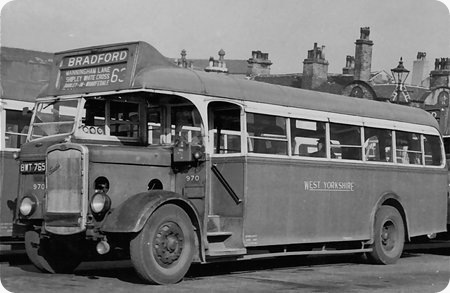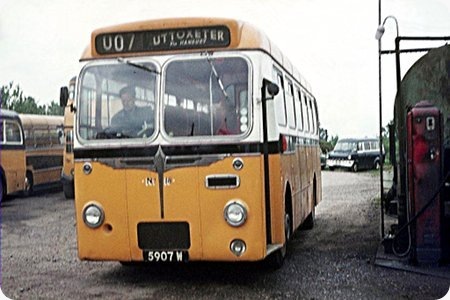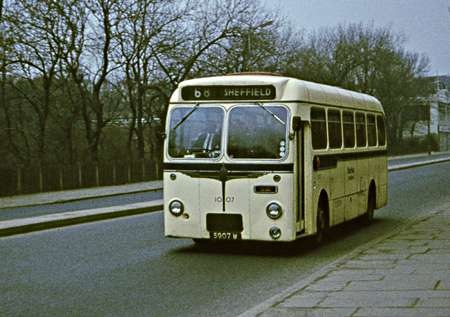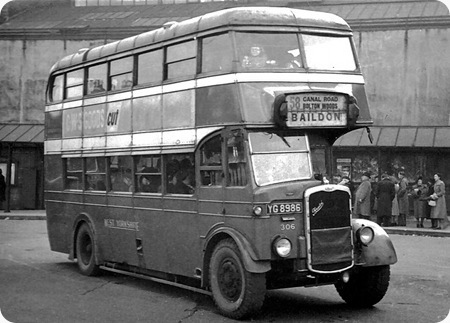West Yorkshire – Bristol JO5G – BWT 765 – 970
West Yorkshire Road Car Company
1937
Bristol JO5G
ECW B32F
West Yorkshire Bristol JO5G 970 with Eastern Coach Works (ECW) B32F body built in 1937 is also seen at Bradford Chester Street Bus Station about 1950. It would appear to being used as a temporary crew rest room after a duty on a service from Ilkley. This bus was was one of a further twenty eight “Js” rebuilt by ECW with a roller blind indicator box to replace the “bible” indicator. Bristol JO5G 970 was part of a large fleet of over one hundred bought between 1935 and 1937 and the “Js” could be seen operating over a wide area of the West Yorkshire Company network. 970 was withdrawn from service at the end of September 1954 and the last in the fleet JO5G 996 went out of service in May 1955.
Photograph and Copy contributed by Richard Fieldhouse
———
06/03/11 – 09:19
Another wonderful picture of particular nostalgia for me, as I lived in Ilkley in those days, travelled often on service 63, and when I joined West Yorkshire in 1960 worked on the route frequently. Although the installation of the postwar pattern full size roller destination boxes was an obvious improvement for all concerned, the fitment always seemed to me to be a little excessive in height and took something away from the beautiful classic lines of these vehicles. I had completely forgotten that the intermediate display was as comprehensive as shown in the picture – later editions settled for "Manningham Lane, Shipley, White Cross" and "Burley in Wharfedale" was certainly a bonus. West Yorkshire was one of those companies who liked to stick to three digit fleet numbers, which brought about an interesting point with this batch : In the 1937 delivery BWT 794 became 999, thereby "bursting the thousand", and BWT 795 became 101.
Chris Youhill
———
06/03/11 – 11:55
Absolutely wonderful photograph which again takes me back further than I would care to admit!
WYRC allocated fleet numbers on a "hundred" block basis, service bus single deckers going on to a new "100" series when the 900 block was exhausted. I well remember riding on these "J"s , particularly from Bingley to Dick Hudsons, and it was these buses which evoked those memories of internal transfers which were discussed some weeks ago. "Please tender exact fare and state destination" etc!
I agree with Chris that the classic lines of the ECW body were somewhat spoiled by the roller blind conversion, which always seemed a bit "spasmodic" as to why some were and some were not converted.
I remember riding on the last "J" in service, in 1955, on an enthusiast tour from Bradford to York, where we also sampled the delights of the 3 "ADG"s, a story to be told elsewhere.
A delightful photograph Richard, and what a contrast between these later BWT registered J types and their earlier squarer ECOC bodied elder cousins with YG, AWW and AWX registrations!
A fleet with very strong Tilling influences, and yet how strange that the body layout, if not style, was typical of BET practice, with the front porch style door. Superb rugged, reliable buses which just oozed atmosphere and character!
John Whitaker
———
11/03/11 – 07:44
I’ve never driven a Bristol J or G, but K (in service) and L (in preservation) are old friends. A letter in Buses Illustrated about 40 years ago (I’m afraid I’ve forgotten the exact wording) suggested that–unlike the London RT driver–the poor provincial Bristol driver had to wrestle with heavy, awkward controls. Nothing could be further from the truth. Steering is light and dead positive, brakes are progressive and trustworthy, the clutch allows a nice smooth takeup, the gearbox is less demanding than some and has sensible ratios and the cab is comfortable: in short, an ideal driver’s bus. Or was I always lucky enough to get the good ‘uns?
Lovely evocative photograph! Thanks.
Ian Thompson
———
11/03/11 – 11:13
I agree with you fully Ian on every point there, and in particular concerning the brakes – I always found Bristol brakes to be completely predictable and reliable at all times. In my own view, and I appreciate that every driver has his/her favoured model, the Bristols of that era shared friendly top place with the Leyland PS1/PD1 for a pleasant and comfortable driving experience and absolutely no hidden vices.
Chris Youhill
———
11/03/11 – 17:51
I think it is what the onlooker sees (or thinks he sees). The pre-selector gearbox, especially on AEC Regents, always looked and sounded quick, smooth and light to operate. Manual gear change (before synchromesh) required the pause to let revs die down when changing up, or the blip on the accelerator to speed them up when changing down. So it was a slower change, accompanied by mechanical sounds that gave the impression of was hard and heavy work. Derby’s Fodens and Bartons’ Utility Guy Arabs certainly always looked and sounded as though they were pigs to drive – but there again I may be quite wrong.
Stephen Ford
———
12/03/11 – 07:11
Stephen, the Fodens were not at all hard to drive in terms of physical effort, but the gearboxes required spot on precision and were very unforgiving. Any miss-match of road speed and engine revs produced a high pitched screech rather akin to applying a piece of metal to a power saw and was most embarrassing. The Guy Arabs (early marques including the utilities) had easily manageable gearboxes, once you remembered that some were "back to front" in that first and second were nearest to you, and third and fourth were against the engine panel. Those Arabs did though have very heavy clutches and much effort was also needed to press the accelerator hard enough once the governors engaged. Despite these observations though I don’t think either model could fairly be described as "a pig to drive" – provided you were interested in the job they were rewarding and very tough vehicles, and I’d just love an hour on each of them right now.
My favourite bus at Samuel Ledgard’s Otley Depot was the Roe rebodied utility Guy Arab JUA 763, with "back to front" gearbox – I used to take it out at every opportunity. The placid little garage man who allocated the buses was always aware that he might have it on his hands to the last each morning as the undedicated brethren shunned it. His face would light up with relief when I appeared and, pencil poised, who would enquire "763 kid ??" and with a happy smile delete the number on his little list. My next task was then to try and pacify with cigs, sweets or teas the disgruntled conductors who would mutter "narrow gangways and only one bell upstairs."
Chris Youhill





